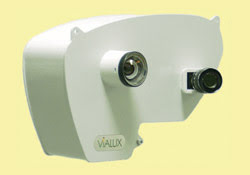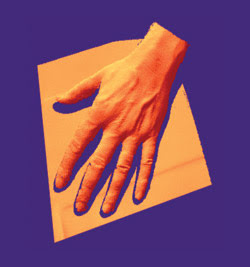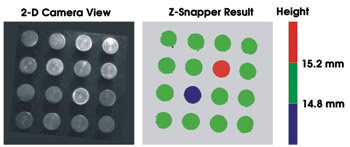Richard Gaughan, Contributing Editor
Traditional machine vision applications examine the shape and color or the feature size and orientation of an object, but they typically do so using two-dimensional projections of the scenes before them. Ful three-dimensional views would provide critical inspection information, but the practical difficulties associated with acquiring 3-D data have been prohibitive. A new instrument overcomes many of those problems and offers 3-D imaging in a portable, low-power, rapid-acquisition package.
The z-Snapper from Vialux Messtechnik + Bildverarbeitung GmbH of Chemnitz, Germany, uses a digital micromirror device from Texas Instruments Inc. of Dallas to project a series of sinusoidal fringe patterns onto a target.

The z-Snapper from Vialux uses Texas Instruments Inc.’s digital micromirror device to project patterns of sinusoidal fringes. The VGA camera processes the fringe patterns to reconstruct the object height.
A CCD camera, positioned at a fixed angle relative to the projection optics, images the scene illuminated with the fringe pattern. If the fringes are projected onto a flat surface, the measured fringe pattern will continue to be a smoothly varying sinusoid. If the pattern is projected onto a 3-D structure, however, the lighted and shaded areas will be displaced in the X- and Y-dimensions, depending on the height of the illuminated structure.
The new instrument processes the acquired pattern to reconstruct the 3-D shape of the object. To eliminate ambiguities in height, it acquires a series of images using different phases and/or wavelengths in the projected pattern.

The instrument is suitable for use in applications that are problematic for traditional machine vision systems. The added information about the height of an object enables the z-Snapper to distinguish objects against a similarly colored background.
To be effective on the factory floor, a machine vision system also must be fast. Regardless of the accuracy of a 3-D imager, if the acquisition and processing times are too long, the data cannot be used to efficiently feed back into a production line. The z-Snapper has a maximum frame rate of 74 fps and employs a FireWire interface to transfer the image data from the 640 × 480-pixel, 1/2-in. CCD. The digital micromirror device at the heart of the system typically projects three patterns in successive frames, completing a measurement sequence in 0.04 s. The height resolution in this mode is on the order of the lateral resolution of the VGA sensor: 200 μm at a 300-mm range. Using 40 additional projected patterns improves the depth resolution to approximately 15 μm rms, but the more than 300,000 measuring points of the standard image provide sufficient resolution for many applications.
Besides speed, portability is also important. The 3.8-kg instrument is designed to be mounted in any orientation or to be handheld. The illumination source is a 700-mW, 450-nm LED. The low power requirements of the LED and the other system components allow the z-Snapper to run on a 12-V battery pack or a standard power adapter. With single-wavelength operation, the system can operate at typical ambient light levels on a factory floor.
Additional design features help keep the instrument efficient and affordable. The 70° field of view of the pattern projection optics is suitable for many machine vision applications, providing a 1.3-m image field at a range of just over 1 m. The brightness variation of the projection system is less than 10 percent over the entire field, distortion is better than 0.5 percent, and the contrast ratio is better than 800:1. The system electronics leverage off a Texas Instruments chip set and include a unique accessory light modulator package. The system can be configured to project hundreds of different patterns at up to 16-bit gray-scale resolution. The flexibility makes the system suitable for both high-speed 3-D testing and high-resolution precision measurements.
Roland Höfling, managing director at Vialux, said that the system can solve problems that are difficult for traditional machine vision systems — for example, testing for the presence of pieces of chocolate in a brown box, white pills in a white package or black rubber parts in a black industrial environment. The system also can be used to measure the height or shape of products as diverse as paving stones, car body components and salmon slices.

Standard 2-D machine vision systems can miss key features. Three-dimensional imaging reconstructs object height, adding another level of information for use in process control or quality assurance.
One of the next development steps is to combine data from several z-Snappers to generate one large 3-D representation of a scene. Höfling said that it is difficult to imagine all the potential applications of fast and accurate 3-D imaging technology but that he expects image-processing scientists to push the development of new 3-D algorithms. “For example,” he said, “edge detection is a quite different task if one migrates from 2-D pictures to 3-D point clouds.”
Contact: Roland Höfling, Vialux Messtechnik + Bildverarbeitung GmbH, Chemnitz, Germany; +49 371 5397 443; fax: +49 371 5397 417; e-mail: [email protected].